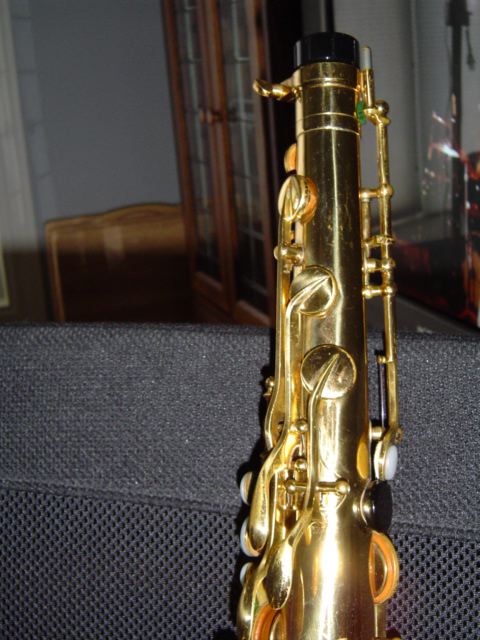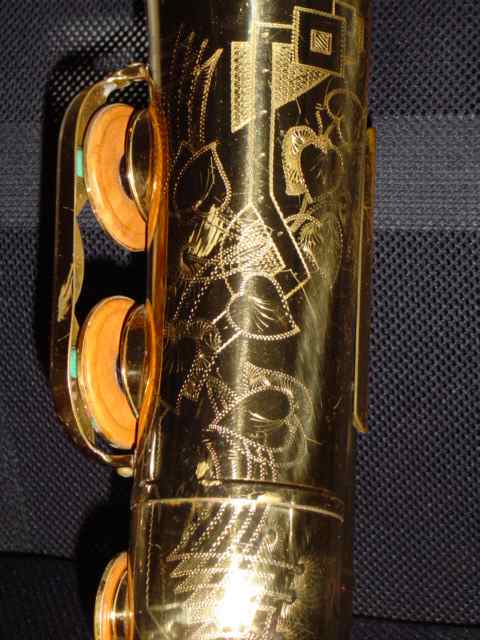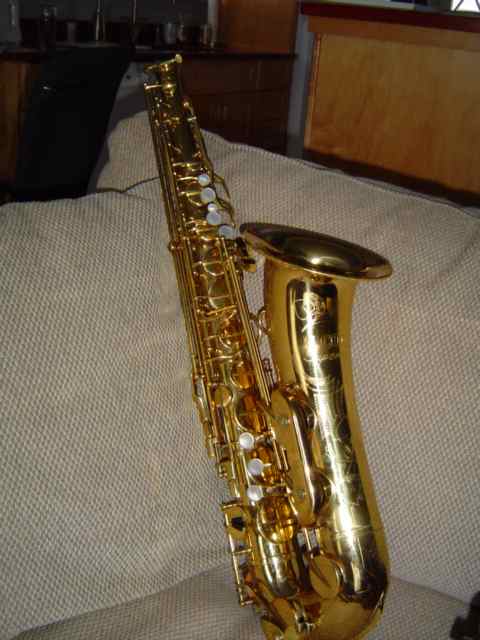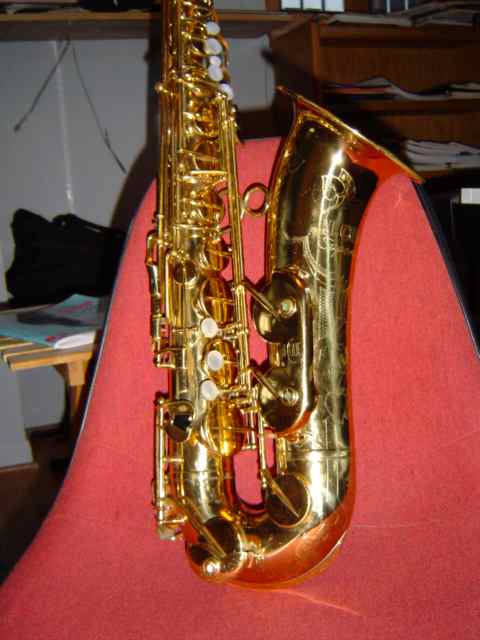Keilwerth [ Back to Top]
Click here to jump directly to the [ Soprano comparison ] [ Alto and Tenor comparison ]
| 192: | 0-800 | |
| 1947 | 20,000 | |
| 1953 | 23,000 | |
| 1958 | 28,000 | |
| 1960 | 38,000 | New King Tenor – acrylic key guard |
| 1962 | 43,000 | |
| 1964 | 49,000 | |
| 1966 | 55,000 | |
| 1971 | 69,000 | 2nd Generation 62xx Couf Tenor with seesaw F# ad high F# combo |
| 1978 | 79,000 | earlier Couf tenor example later Couf alto Black Nickel example later Couf alto lacquer example |
| 1986 | 91,000 | 84xxx Armstrong Heritage Tenor w/3 point key guards Couf Sopranos Couf Superba II tenorFor a short period Conn imported a horn with the designation “Conn DJH”. Conn DJH horns were an improvement over the Couf design while Coufs were still being produced. It had a Selmer type octave key, Tilting Bb left hand table keys and a few other minor improvements. After 1989 Ponzol redesigned the Keilwerth Tenor horns and had a line of his own tenors. These models had true Rolled Tone Holes, removeable bow/body ring and improved intonation, 3 point key guards. |
| 1993 | 99,100 | Around 100,000 Keilwerth went away from true Rolled Tone Holes and started using Tone Hole Rings which are soldered on regular tone holes. |
| 1998 | 109,000 |
Keilwerth Stencils:
Couf Superba 1 & 2 (see information below) (Armstrong) Royalist, Royalist I Heritage (Armstrong) Conn DJH Buffet Edgeware Marco Vincent Albert (1960’s) Martelle Winsall Bundy Special (1960’s) King Tempo Champion Calvert Deluxe
Mr. Herbert Couf, President of W.T. Armstrong group during the 1970s and 1980s had the Couf Superbas and Royalist/Armstrong/heritage line of saxophones all from Keilwerth. Some of which were sold as a competing model. Royalist II and many Armstrong (like the model 3200) saxes were strictly a student line made in Elkhart as a Reverse-engineered Keilwerth Royalist to reduce the cost. Mr. Couf also owned Royal Music Store in Royal Oak, Michigan until 1989. I believe he now owns a home on a local Golf Course.
Also, the engineering group for Mr. Couf made improvements on the Keilwerth design. Gary Ferree (of Ferree tools, RIP) was instrumental in improving the RH alt F# key. It was the seesaw type and he redesigned it to the side type. This also allowed the altissimmo F# keytouch to be redesigned.
Amati, Dörfler & Jörka copied Keilwerths (1949 to 1968, then purchased by Keilwerth) and B&S
The earlier Keilwerth, alto, soprano and tenor all had metal thumbrests. Late model sopranos and altos had plastic thumbrests. The plastic thumbrest had a 2 point connection. This prevented breaking which apparently was a problem on Selmer horns at that time.
Superba 1s (see below for a better description and pictures)
– have Rolled Tone Holes throughout the range of saxes, except for the Soprano.
– has an elegant, soldered, bell brace
– full bell & bow engraving
– lyre holder part of mouthpipe socket clamp mechanism (except soprano)
– neck upper octave key made from thick square brass rod
– Bow soldered directly to bow via an expanded section. Bow soldered directly to body via an expanded section.
No rings were used to combine the sections.
– early superba 1s do not have a high F# key. mid-early Superba 1s have a high F# key.
– early and mid-early superba 1 & 2s have a RH see-saw type F# key. later Superba 1 & 2s have a levered F# key.
– All post to body construction (no ribs)
– Early saxes had a removeable metal thumbrest. Late model sopranos and altos had plastic thumbrests. The plastic thumbrest had a 2 point connection. This prevented breaking which apparently was a problem on Selmer horns at that time.
Superba 2s
– have straight tone holes throughout the range of saxes plus the Superba 1 soprano.
– single rod bell brace
– bell engraving
– lyre holder soldered on separately below the mouthpipe socket sleeve
– neck upper octave key made from round brass wire
– Bow soldered directly to bow via and expanded section. Bow soldered directly to body via an expanded section.
No rings were used to combine the sections.
– early and mid-early superba 1 & 2s have a RH see-saw type F# key. later Superba 1 & 2s have a levered F# key.
– all post to body construction (no ribs)
– all thumbrests were metal and soldered in a permanent position on the body.
Superba 1s, it is said, have a more mellow and lush sound than Superba 2s due to the RTH vs non-RTH. This apparently keeps the stacks stiffer and parts of the body resonates less.
The Superba 2s supposedly have a more cutting sound similiar to Selmers of the time.
Both horns had oversized concave pearls that are very comfortable.
Non articulating low Bb keywork, but very fast and functional mechanisms.
For a few years the Superbas were available in black lacquer. The engraving was done after the lacquer which provided a stunning visual affect of being able to see the engraving from a distance. This models had metal thumbrests and were probably late 70’s models.
Both Superba 1 & 2s were considered Pro models.
H&A Selmer imported an early version of this horn before it became a Couf. These were H&A Selmer Bundy Special horns. Visually identifiable by the RTH (Rolled Tone Holes) and 2 point Bow & Bell Guards with mostly plastic pant leg guards.
H.Genet Roxy Jubilee Voss Rene Dumont
Keilwerth family relatives: Max Keilwerth and Richard Keilwerth (Graslitz) made saxes under the names: Weltklang (baritones only) Senator Hohner
Conn DJH horns were Couf Superba Is and 2s. Rebadged, available in silver plate or lacquer.
Available in the late 1980s before Conn was sold to UMI
Keilwerth EX model line – the EX line can be a very good horn, all depending which model you purchase – the eaarlier ones being made in Germany.
| Model | Made in |
| EX90 | Germany |
| EX90 II | Germany |
| EX90 III | Czech Republic |
| ST 90 I | Germany |
| ST 90 II and III | Czech Republic |
| ST 90 IV | Taiwan (Jupiter) |
Thought I would update this 2/2012 a bit as it is dated and jumbled
Early Couf Alto – no high F#, seesaw alt RH F# and a see through plastic pant guard- SN56462





[ Superba 2 ] [ Heritage Tenor mix ]
Below is a Superba 2 tenor. Notice
ENGRAVING: the “minimal” engravings compared to a Superba 1. The S1 has it onto the Bell.
NECK: The wire octave mechanism versus the Superba 1s square wire.
TONEHOLES: No Rolled Tone Holds (RTH)
All other features are the same and vary dependent upon the vintage




NOTICE:
NECK: Superba 1 type neck
ENGRAVING: Superba 2 type engraving – ie, it does not go low on the bell nor the bow.
KEY GUARDS: Selmer Style bell key guards
BELL BRACE: Notice the Bell brace. Not the double loops of a Superba 1 and not the simple wavy rod of a Superba 2, it’s a wavy cut out sheet.
OTHER: the thumbrest is a double raised point Superba 1 type.









BELOW: A really hard to find 65024 model which has an alternate F# trill, and the high F# is up on the post, with a see-saw alternate F#. Fixed thumbrest.

BELOW: Early model with the plastic G# touch

Superba 1 Tenors:
NECK: square rod (from a flat sheet actually) octave mechanism
THUMBREST: From adjustable metal to double point plastic
NECKSTRAP RING: always really thick, reverse tear drop shape
BELL BRACE: bell brace made from 2 loops design
.

BELOW: Notice the Side F# and high F# touches




NOTICE The extended engraving down through the bow






Another generation of Superba 1
Superba 1 alto

BELOW and early generation of an alto, notice the “H Couf” stampe on the bell key guard









Below: A Black nickel Couf alto Superba 1



Yamaha [ Back to Top]
Model 61 – available in soprano, alto and tenor
Model 62 – improved intonation over the Model 61. available in soprano, alto and tenor.
YTS-62 (original purple silk screen model)
Model 62R soprano – rare curved neck model of the popular YSS-62
Model 855 alto – original top pro model alto
Model 875 sop, alto, tenor – top of the line french brass horns
Model 875EX – alto. Most current production alto.
Model 62 II
Model 82Z – vintage engineering. Special alloy body, 2 halfs of the bell are soldered together.
There are numerous other models including the designations 275, 52, 475, 21 & 23
Vito (Leblanc USA) also had their line of Yamaha alto and tenor line instruments based on the 23. These are identified by the “Made in Japan” or simply “Japan” stamp near the serial number.








